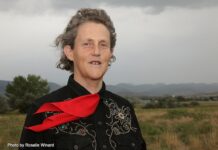WILMOT, Ohio — He doesn’t have much in the way of farm buildings and farm equipment, and most of his livestock live outside — on pastures and in the woodlands that he owns.
But Virginia-based farmer and author Joel Salatin certainly doesn’t consider himself poor.
He told a crowd of 3,000-plus at the annual Family Farm Field Day, July 16, that the average farmer in America spends $4 in depreciable infrastructure to turn $1 in annual sales. On his farm, it costs just 50 cents to produce $1.
“Our equity is not in machinery and buildings; our equity is in skill, information and customers,” he said.
Skills and information are still costly, he said, and valuable — but not something that a bank cannot take away.
About his farm
Salatin lives and farms on his family’s Shenandoah Valley farm, where he raises pork, beef, poultry and eggs — using a pasture-based system that he feels allows the animals to express their natural behaviors.
His farm is called Polyface, which means “the farm of many faces.” The farm is rooted in polyculture, or the growth of many things, and is known internationally.
Family Farm Field Day is an annual gathering of farmers and the public — usually held in Holmes County and attended by Amish, but open to others.
Salatin spoke multiple times throughout the day, calling for a return to biological farming, and warning of the cost and perils of mechanical farming.
In a morning talk on “salad bar beef,” or the concept of rotational grazing — he pointed out the potential to raise healthy cattle on the God-given vegetation already available.
More growth
He said before Europeans arrived, the country was covered with growth, including wild animals like wolves, beavers and bison, that maintained a natural cycle and order.
“There was a tremendous amount of productivity here before we ever arrived,” he said. “In fact, more than there is today.”
His goal, when he took over the family farm, was to identify the “patterns” and “choreography” of life, and mimic that as closely as he could.
He keeps about 1,000 head of cattle on a rotational grazing system, and strives to move them to new pasture on a daily basis. He said cattle are the “pruners” at his operation, and just like pruning a vineyard or orchard — it’s important to only prune the right amount, at the right time.
By moving the cattle daily, he feels they do less damage to the grass, and are more likely to stimulate new growth in new places. He challenged farmers to be deliberate in their grazing efforts — focussing on each day, and making sure each pasture or paddock is sized to the number of cattle that it keeps.
He demonstrated how he measures off each pasture with fence, and said he doesn’t worry about straight fences — because he wants to follow the contour of the land.
Factory farming
In a keynote address over lunch, Salatin said he can’t imagine a more troublesome environment for livestock than “factory farms,” which raise livestock in controlled, enclosed environments, usually of single-specie.
“You could not conceive nor contrive, or come up with a more pathogen-friendly system than we have,” he said.
While Salatin spoke critically of industrialized farming, he said it’s also not as easy as telling farmers what to do, or how to farm. He’s also not in favor of the government telling people how to farm.
“Farmers do what consumers buy, and when consumers buy Hot Pockets and frozen pizza, that’s what the food system gives them — cheap,” he said.
Salatin’s farm provides food to more than 6,000 families in a three-hour radius, and supplies restaurants and select stores.
Although local foods can sometimes be more costly than other options — Salatin said there’s still room for people to eat healthier, if they choose to.
For example, he said for what one person spends on one value meal at a fast-food restaurant, the same person could buy two pounds of grass-fed beef.
Learning to cook
But buying the raw ingredients takes time, and you have to know how to cook.
In the afternoon, a panel of three growers discussed how they provide fresh food to urban customers — and how they help educate the public about healthier eating and cooking at home.
The loss of cooking knowledge has led people to move toward convenience foods, but thanks to Community Supported Agriculture, or CSA, more people are returning to cooking. A CSA is a farmer-consumer contract in which the grower provides the customer a weekly allowance of fresh foods.
The foods are boxed or packaged for each customer, and because the customer pays for them up front — like groceries — the customer usually feels a sense of urgency to make sure everything gets eaten.
“They don’t want to waste it, so they’re going to try to eat it,” said David Yoder, a CSA grower from Fredonia, Pa. “It’s almost like you’ve forced them to eat healthy and eat the stuff they normally wouldn’t.”
Customer’s perspective
Scott King, a CSA customer from Columbus, said he buys for his family of five, which includes three young children. He’s found himself cooking and trying new things, because he wants to use up everything he buys.
But at the same time, he said some things do go to waste — just as with grocery store food. This is especially true during family vacations, or times when he’s not home to cook.
The customers of CSA can be urban, suburban — or basically anyone who likes having a fresh supply of food, and knowing from which farm it came.
“There’s about as much variety in the customers as there is on the farm,” Yoder said. “We have people with pony tails and sandals, and we have people who wear businesses suits.”
The day featured various other talks and presentations on topics that included beekeeping, deer and wildlife management, and farm and road safety. The Ohio Department of Natural Resources helped lead the outdoors sessions, including a presentation on pond fish.
The Holmes Burn Care Foundation led a talk on what the foundation does to help burn victims in the Amish community, and what families should do to treat and care for various types of burns — and when to seek professional help.
About the event
This year’s event was held at Wholesome Valley Farm, which serves as a hub for organic and pasture-based livestock within the Amish community.
Lloyd Miller, one of the coordinators, said the biggest thing he hoped people got out of the day was “relationships.”
“My whole goal is that we can restore relationships — people among people and relationships with our own land and our own animals,” he said.
Miller said organizers are considering holding future Family Farm Field Days at this same location, because it is better suited for inclement weather and large crowds. The event has drawn as many as 5,000 people, and is free to attend, although donations are requested.










Thanks, Chris! Much wisdom here. The day I quit learning is the day they plant me!
SO much information was left out!!! Perhaps readers SHOULD be informed!! It is very easy for Saladin to afford to ‘preach’ to other farmers when the truth is told…Saladin makes most of his income charging speaking fees to ‘preach’ about his ‘methods’ and also receives other payments from his books/engagements. He also utilizes ‘interns’-a fancy name for FREE workers. He picks and chooses which modern technology to utilize-does NOT use horses/oxen but tractors. As far as his food prices are concerned-the average American could NOT afford to purchase his products-but he is fortunate to live near an area where people have a higher income and can afford to purchase it. People I know that have visited his farm decided not to purchase poultry there because they felt his processing was too unsanitary.
Sound like I am harsh on him?? He continues to attack modern farming practices even though his methods are no cleaner nor profitable for farmers. He dupes people by not fully disclosing his methods-if all farmers had free labor they would ALL be profitable….if he wants to promote his methods-fine…but STOP attacking/smearing those with different methods. THAT is the problem with Saladin.